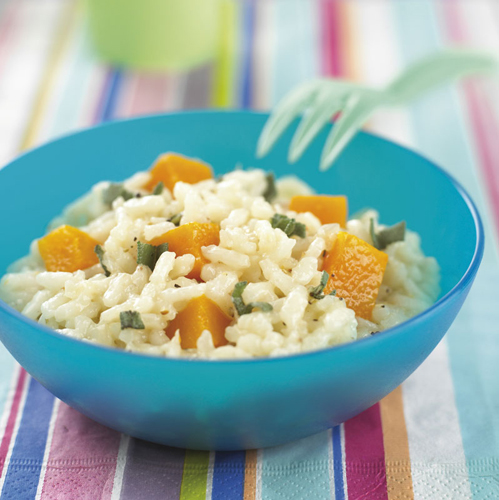Some babies are undoubtedly persnickety, choosing the same foods over and over again, and turning up their noses at the sight of anything new. The good news is that you can still offer a delicious, varied, and healthy diet by using a few tried and tested tricks—and, of course, a little subterfuge when necessary!
| Q: |
Is it possible to convert a baby who has been fed only baby food from jars?
| | A: |
Of course it is! Start by throwing away the jars and offering her
family meals. For one thing, your baby will feel thrilled to be
involved, and she is now old enough to have more or less the same things
that everyone else is eating. If she proves to be resistant, you can
mix a little bit of her usual jarred food with whatever you are eating,
and then gradually change the ratio until she is eating different
things. Once she becomes accustomed to different tastes, she’ll be less
likely to resist what you are offering, and if she feels that she is
involved by eating with the family, she’ll be unlikely to create a fuss.
If you need to, you can
get a little sneaky and fill her jars with your own homemade creations.
Start by recreating her favorite jarred foods, and then gradually
change them until you have her eating what you want.
|
| Q: |
How can I prevent my baby from developing a sweet tooth?
| | A: |
It’s sometimes hard, but try to avoid offering your baby anything
with added sugar, and make sure that his meals are based around
vegetables rather than fruit, which are naturally sweeter. Try also to
offer fruit purées only when he has had his fill of her vegetable
purées.
|
| Q: |
My baby won’t eat anything but fruit and “sweet” vegetables. Could she already have a sweet tooth?
| | A: |
Yes, babies quickly develop a sweet tooth, and, ironically,
breastfed babies seem to develop one more quickly because breast milk is
naturally sweet, and, really rather delicious! The best thing to do is
to start introducing less sweet fruits, such as tart apples and berries,
and then mix them with your baby’s normal food. You can also start to
blend together some less sweet vegetables, such as zucchini, broccoli,
cabbage, and kale with your baby’s sweeter vegetable purées.
A little at a time works well, and she will soon forget the original sweetness that attracted her in the first place.
|
| Q: |
Is there any way to make vegetables more appealing for babies?
| | A: |
The good news is that babies don’t actually dislike vegetables in
the same way that toddlers do! If they become accustomed to eating them
regularly, and from an early age, they will develop a taste for them.
This is one reason why it’s a good idea to introduce vegetable purées
and finger foods well before you offer the fruity options, and most
certainly at the beginning of the meal.
If your baby has
always been resistant to vegetables, try blending them with a little
fruit to make them more palatable. And at the outset, offer some of the
more naturally sweet options, such as sweet potatoes, squash, and peas.
Cubes of these make excellent and nutritious finger foods, too, and will
encourage your baby to experiment with different textures.
You can add a little
milk in your cooking, as well as yogurt, cheese, herbs, spices, little
bits of meat, and pulses to prepare delicious vegetable-based meals. If
it’s the texture that puts him off, purée the vegetables into sauces,
like a bolognese or tomato sauce, and combine with tiny pasta shapes, couscous, or rice. Try giving him raw vegetables too.
|
| Q: |
My baby doesn’t like fish. Is it very important?
| | A: |
Fish is important for a number of reasons. It offers a fantastic
source of protein, and oily fish in particular (such as fresh tuna,
mackerel, salmon, and sardines) has very high levels of EFAs (essential
fatty acids), which are required for optimum growth and development,
especially visual and brain development.
It may be that
your baby doesn’t like the particular fish you have chosen. Why not
start with something simple like cod or haddock, and mash a couple of
teaspoons of poached fish into some mashed potatoes? Salmon can be mixed
with mashed potatoes, some finely chopped scallions, and a little
ketchup to make tasty mini-fish cakes. Or make goujons of fish. They’re simple to make and are great finger foods.
Just keep on offering fish in different guises, and hide it if you need to. It’s very important!
|
Did you know…
that the majority of
babies will object when their familiar foods are replaced by something
different? It’s important to recognize that this is completely normal.
Offer her the foods she likes alongside new ones and continue to do so.
It can take many “sightings” before your baby will recognize a new food
as being familiar. You can blend new and familiar foods together, to
accustom her to the taste. Try different combinations of foods or
different recipes.

Salmon, Carrots, and Peas with Cheddar
Salmon is a very nutritious fish, but it has such a strong flavor that your baby might not like it at first. Mixing it with potatoes and carrot will make it seem more familiar.


5 minutes
10 minutes
NOTE
About 6 baby portions
2/3 cup vegetable stock or water 1/2 potato, peeled and cut into small dice 1 carrot, peeled and cut into small dice 4oz skinless, boneless salmon fillet, cut into 1/2in cubes 2 tbsp frozen green peas (preferably petite peas) 1/4 cup shredded mild Cheddar cheese 1–2 tbsp breast milk or formula
Put the stock in a
saucepan with the potato and carrot. Bring to a boil, then reduce the
heat, cover, and simmer gently until the potato and carrot are just
tender, about 6 minutes.
Add the salmon and peas, cover again, and simmer until the fish flakes easily and all the vegetables are tender, 3–4 minutes.
Transfer the contents of
the saucepan to a bowl and add the shredded cheese. Mash to the desired
consistency, adding a little breast milk or formula, if necessary. The
mixture can also be blended to a purée if your baby prefers a smooth
texture.
Cool as quickly as
possible, then cover and refrigerate. This can be frozen in individual
portions; when needed, thaw overnight in the refrigerator, then reheat
until piping hot. Stir and let cool slightly before serving.
|